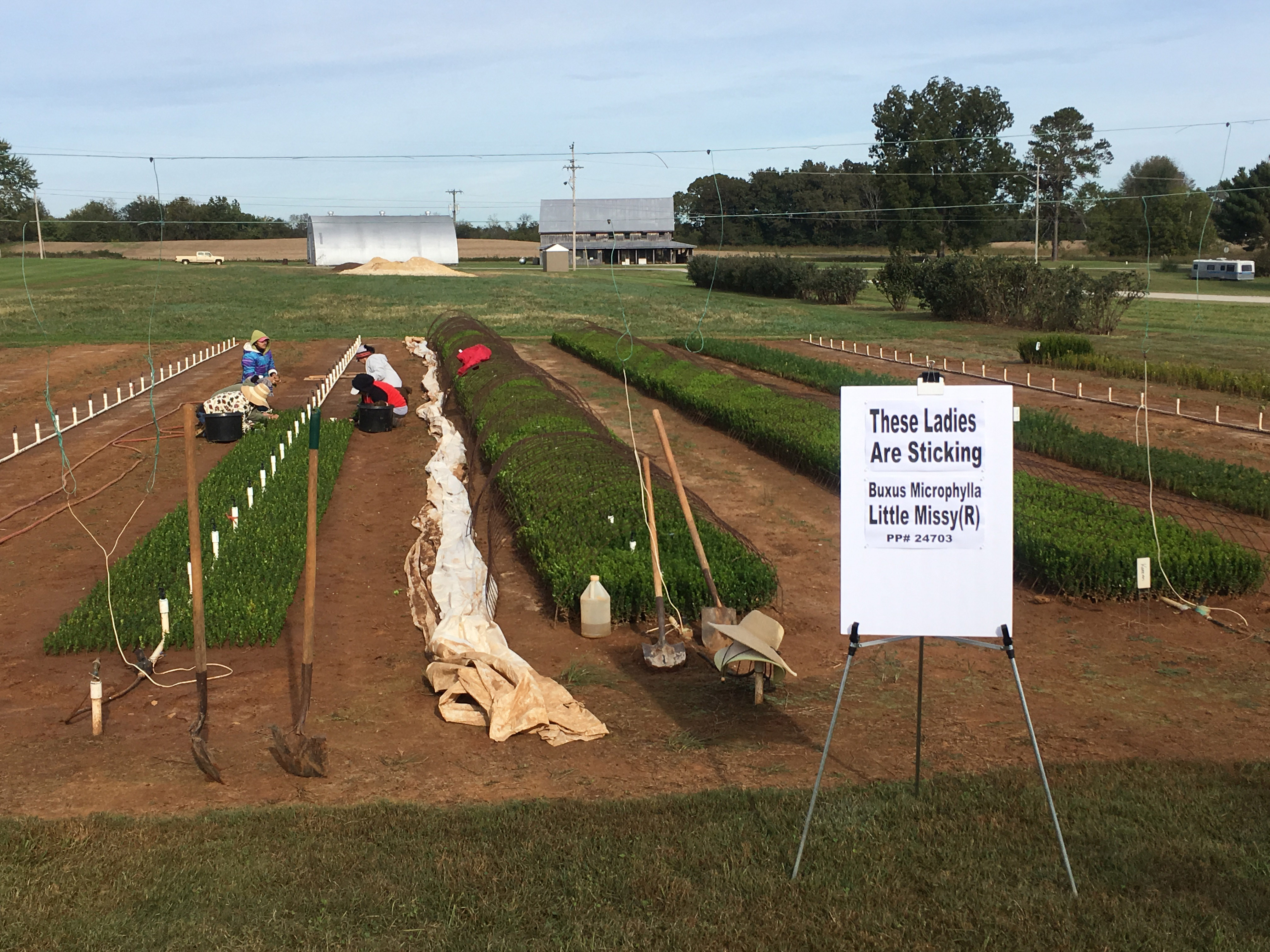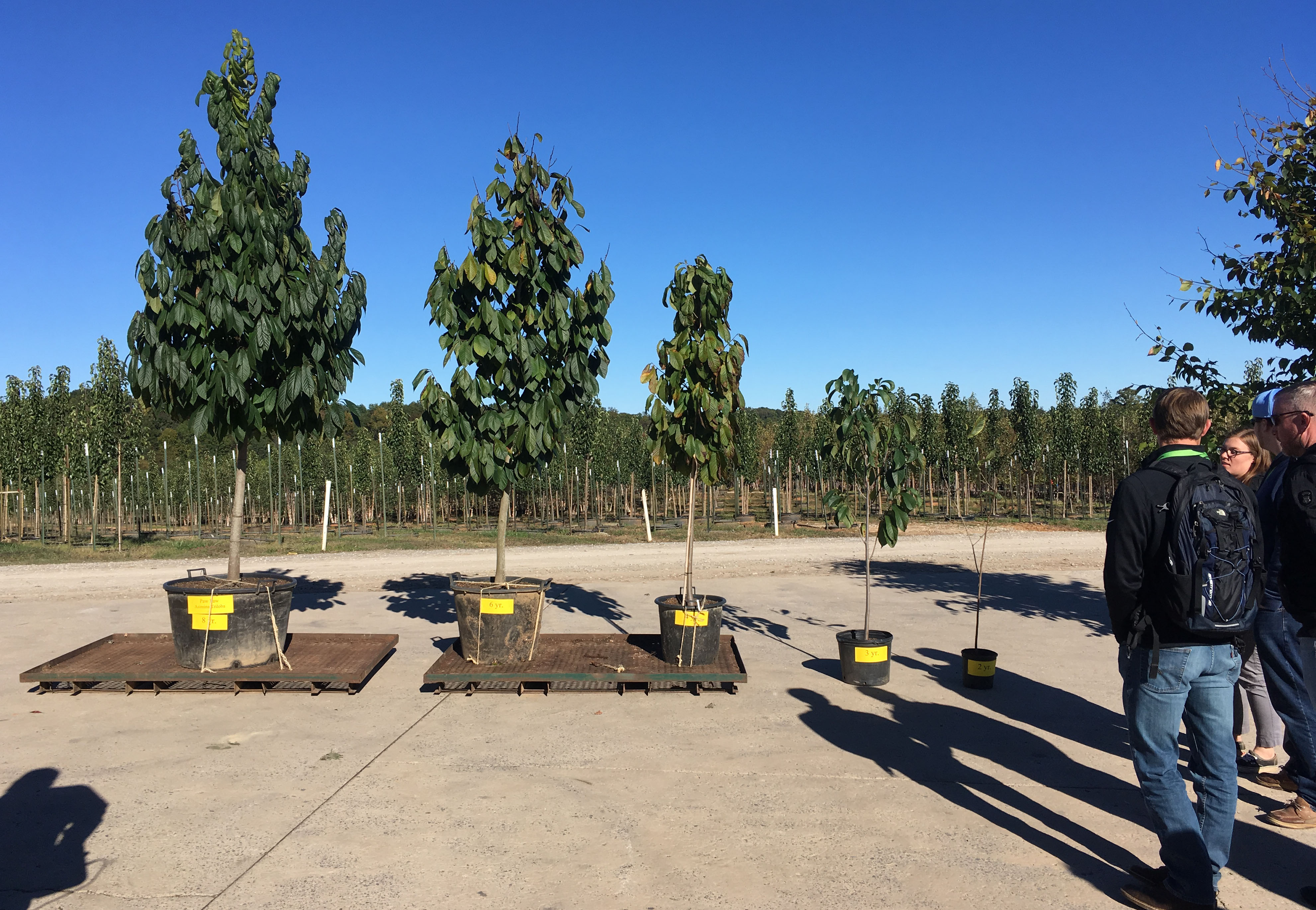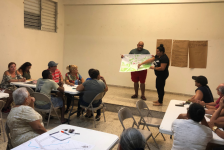Mastering plants as a design material is a life-long challenge. Learn the names, qualities, and ecological preferences of any of the hundreds of potential species you could use and – guess what? – you’re only halfway there.
As a landscape architect, you probably won’t have direct control over the plants that go into your project – instead you create instructions (a plan, a plant list, maybe some notes) that will enable someone else to build the landscape and achieve the outcomes that you have envisioned. The better you get at creating those instructions, the more likely you are to end up with design outcomes that match your intent. I’m going to introduce you to the basics of how we think about specifying plants at Coastal Vista Design, as well as some of the common issues we’ve encountered with plant specifications.

The Mussaenda on the right and left are in the same size container – which do you want for your project?
DESIGN
Planting design can absorb all the time and resources you’re able to give. So, from the outset of any project, you need to understand the parameters for planting in this specific design. In general, complicated layouts and a greater number of species (especially rare species) exponentially increase a contractor’s costs in installing the plan – and also the cost to your client. If you’re doing a minimal-budget design for a commercial space, your plants should be easy to source, install, and maintain. By contrast, if the project has a budget for you to spend time administering the construction, sourcing plants, and spending many hours on site doing layout – let your imagination and plant palettes go wild!
Most landscape contractors will not be growing the plants they use in installations themselves. Instead, they source them from wholesale nurseries – often referred to as growers. Different growers specialize in different types of plants, usually depending on how the plants are produced (in plastic containers, in the open ground, or some combination thereof). The availability of different plants depends widely on where you’re working. Some US regions (south Florida, Oregon, California, and Tennessee for example) have large nursery industries and many growers occur in close proximity, making it easy for landscape contractors to procure a wide variety of plants. Other regions may have to transport plants from far away. If a contractor has to make special trips to sources for specific plants, those extra trips will be reflected in their pricing and likely in their attitudes towards you as the designer.
If you’re starting off in your career (or in a position with a new studio), pay attention to your studio’s typical palettes and specifications. Local codes are also a major factor in determining required planting, so ask about special parameters in the regions where you work. When you’re starting out in your career, you’ll need to learn as much as you can from planting experts in the studios where you work, as well as the install and maintenance workers who care for projects you’ve designed.

Construction administration on large projects can include verifying the condition and size of trees delivered to a site – as Leigh Gevelinger, principal of Coastal Vista Design, demonstrates here
CONSTRUCTION ADMINISTRATION
Beyond the physical design, consider your role in the project. How involved will you be in construction administration? As briefly mentioned in the introduction, most landscape architects aren’t directly installing planting. Instead, you’ll be creating instructions for other people to install plants and fulfill your design intent.
If you have a construction administration (CA) scope on the project, you may be more involved with approving or sourcing the actual plants to be used for your project. The most common CA task is accepting or rejecting plants. A landscape contractor will send you photos of plants they’ve sourced for you to confirm or deny whether or not they meet the specifications you included in your plans and bid documents. Use this power carefully – rejection should be firmly rooted in your design specifications.
For a few select materials, you may need to do sourcing trips to flag specimens. These would typically only be the most iconic and high-dollar items. Go into flagging trips with a strong idea of exactly the physical size and form you need for specimens for this specific project. It’s easy to get overly excited and want to just start shopping, especially if you’re with an enthusiastic client.
If you’re working on a project with a large number of unusual species, special demands, a long timeline, and a client with a generous budget it can be useful to figure out how to have plants produced specifically for your project. This is referred to as contract growing in the industry. It would typically require a client/contractor to put down a deposit of some percentage of the cost of the plants in order to secure them prior to installation. Contract growing is only an option for specific projects, but it is the most secure way to ensure that plants are being produced exactly as you need. For slow-growing species and large specimens, there’s still a limited aspect to the exact parameters you can achieve through contract growing – you won’t be able to get slow-growing trees or palms to specimen sizes in 3 years.
Even with construction administration for a project, be aware of the value of your own time. Are you consistently having contractors call because they have issues with how you’re specifying plants? Sometimes, a certain species or selection is important. For example, you may need a certain species – Spartina patens is 18” tall, while Spartina bakeri matures at 4-6 ft – or a specific selection – a grafted male Ginkgo, to avoid decades of messy and smelly fruit. Try to use unusual selections and hard-to-source plants in limited areas and only where it makes a significant difference to the design.

In some parts of the country, plants are still started with cuttings directly stuck into the ground to root – as these workers are doing with boxwood
PLANT SIZING
The nursery trade is complicated and varies from region to region – especially in how plants are sized. In the United States, we do have some forms of standardization and consumer protection around nursery plants. I’ve detailed some resources below in the notes.
In practice, the biggest distinction in specifying plants is typically between trees and shrubs/groundcovers. Trees are typically sized using calipers and/or heights. Caliper is the diameter of the tree’s trunk, typically measured at “breast height” (caliper is sometimes abbreviated as DBH – diameter at breast height). For deciduous trees which gradually increase in caliper over their lifespans, this measurement works. However, for palms (which don’t increase evenly in caliper as they grow) or for multistem trees, specifying by height is be typical. Code enforcement can be a complicating factor. Make sure that you list ALL requirements to make sure that your proposed plantings fulfill all code requirements. For example, if code requires your trees to be 2” caliper and 14’ overall height, make sure that your plant schedule specifies both of those things. You don’t want a contractor showing up with a 2” caliper tree that’s only 13ft high.
Traditionally, trees were grown in open fields (the industry term is “field grown”), with their rootballs either wrapped in burlap or growing directly in the ground. Since the 1960s and proliferation of cheap plastic, trees are increasingly grown in ever-larger containers. Many species transplant better when grown in containers, since their roots are less disturbed when transplanted than if they’re dug from the fields. You may see or specify gallon-sizes on trees, but often the safest bet is to specify by height.
Unlike trees, shrubs and groundcovers are typically specified by container size. In the US, this is listed in gallons. Confusingly, gallon is usually used more as a vernacular term rather than a specific volume so plants with a specified gallon size may arrive in containers of different sizes and shapes. Shrubs are typically 7-gallon, 10-gallon, 15-gallon, or 25-gallon sizes. Groundcovers are typically 1-gallon or 3-gallon. Smaller than 1-gallon plants are specified as plugs or 4-inch containers.
Most shrub and groundcover species have one or two sizes at which they’re most typically sold (the industry term is “finished”). Spend some time with availability lists for regional nurseries and you’ll see which sizes are typical. Again, check the code requirements – make sure to include any height requirements as well as gallon sizes for code-required plants.

This image demonstrates pawpaws at different ages, from 11 years old on the left to 1 year old on the right
GROWTH RATES
I often hear complaints from landscape contractors who are annoyed because (other) landscape architects specify plants in unusual sizes – or unfeasible combinations of gallon size and height.
Unfortunately, there is no overall rule of what size a plant in a specific gallon size will be. Plant species vary widely in their habits and their growth rates. Plant costs reflect the space, resources, and labor required for care for them over that time. Understanding the general growth rate of the species that you’re specifying is a first step.
Many of the most desirable plants, especially for urban projects, tend to have slow growth rates. They’re often stronger, more long-lived, and less likely to outgrow a designated space than fast growing species. This slow-growing nature is reflected in their price.

These Mussaenda are in full bloom on the right, but about ready to be cut back and stored for winter (on the left)
SEASONALITY
Depending on where you work, plants may have differing availability across the year. In temperate climates, spring and fall are often the primary planting seasons when the widest array of plant species will be available. In tropical/subtropical climates, you can plant at most times of year – but some species still have seasons of more limited or widespread availability.
Even if a plant doesn’t have a strong seasonality when established in the landscape, it may have times of year when it struggles under nursery conditions. Last year, in early spring installations, we had extreme difficulty getting contractors to procure nice Mussaenda. Talking to growers, I found out that – while completely fine in gardens – mussaenda tend to rot in cooler weather and get diseases in the nursery, so the growers tend to get rid of them prior to the cool months.
Understanding the seasonal availability patterns in the area where you’re working will require coordination and research. If you’re new to an area, refer to my earlier piece on “5 Top Planting Design Resources for New Landscape Architects”. These resources can help you establish an understanding of plant availability in your area.
Work your whole career in one region and you still won’t know as much about the specifics of certain plants as a landscape contractor, grower, or horticulturist who works with plants on a daily basis. However, a general understanding of plant production and installation processes will help you create better instructions for the people trying to realize the vision in your brain.
RESOURCES
These considerations reflect my experience working with multiple planting-focused studios throughout the southeast United States as well as our team’s robust experience with South Florida planting design and construction. For more technical information, refer your region’s legally-established plant specifications. In the US, these typically occur at the state level, at least in states with significant nursery operations, and are typically handled through the Department of Agriculture. In Florida, the Department of Agriculture and Consumer Services has a legal document Florida Grades and Standards for Nursery Plants which serves as the basis for plant specifications. California uses the terms “California Nursery Stock Grades and Standards Laws”. Oregon refers to them as “Grades, Standards and Labels for Agricultural and Horticultural Products”. Check with your state Nursery Growers Association if some quick searches don’t turn up the relevant standard where you’re working. If you’re working somewhere without state standards, it can be useful to refer to AmericanHort’s “American Standard for Nursery Stock”. In the European union, the European Nurserystock Association produces “European technical & quality standards for hardy nurserystock”, to which adherence is voluntary, with different countries having their own quality standards. In China, the Administration of Quality Supervision, Inspection, and Quarantine (AQSIQ) handles quarantines for imports and standards around nursery stock. I am unfamiliar with nursery standards in other countries, but would be excited to learn of any resources that are working towards international standardization – or even just a of summary resources on international nursery stock standards.
Published in Blog, Cover Story, Featured










Pingback: Getting What You Want: Considerations in Specif...